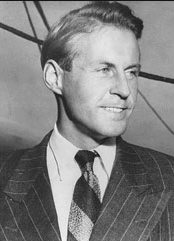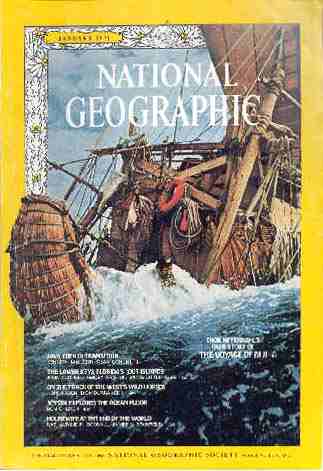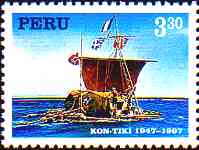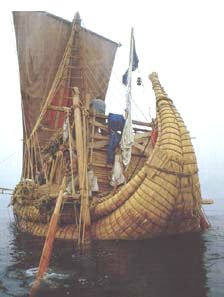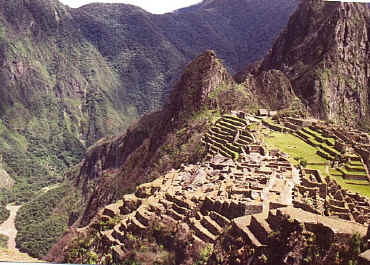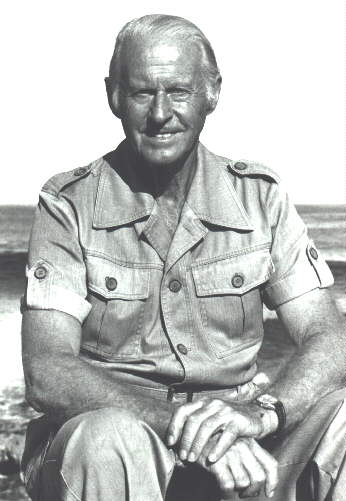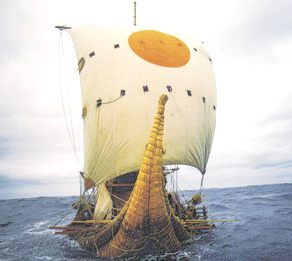|
THOR HEYERDAHL and the RA EXPEDITION
|
|
|
HOME | BIOLOGY | FILMS | GEOGRAPHY | HISTORY | INDEX | MUSIC | SOLAR BOATS | SPORT | SPONSORS |
|
|
Thor Heyerdahl (October 6, 1914 in Larvik, Norway–April 18, 2002 in Colla Micheri, Italy) was a Norwegian marine biologist with a great interest in anthropology, who became famous for his Kon-Tiki Expedition in which he sailed by raft 4,300 miles from South America to the Tuamotu Islands. He died, aged 87, from a brain tumor.
Thor Heyerdahl 1947 - 2002
The Kon-Tiki expedition
In the Kon-Tiki Expedition, Heyerdahl and a small team went to South America, where they used balsawood and other native materials to construct the Kon-Tiki raft. Kon-Tiki was inspired by old drawings made by the Spanish Conquistadors of Inca rafts. After a 101 day, 4,300 mile journey across the Pacific Ocean, it smashed into the reef at Raroia in the Tuamotu Islands on August 7, 1947, showing that pre-historic peoples could have traveled from South America. The only modern technology the expedition had was a radio, food in the form of military rations, and fresh water in 56 small cans. While en route, the crew supplemented their diet by fishing. The documentary of the expedition, itself entitled Kon-Tiki, won an Academy Award in 1951.
This expedition demonstrated there were no technical reasons to prevent people from South America from having settled the Polynesian Islands. Nevertheless most anthropologists continue to believe, based on linguistic, physical and genetic evidence, that Polynesia was settled from west to east, migration having begun from the Asian mainland.
Heyerdahl's theory of Polynesian origins
Heyerdahl claimed that in Incan legend there was a sun-god named Con-Tici Viracocha who was the supreme head of the mythical white people in Peru. The original name for Virakocha was Kon-Tiki or Illa-Tiki, which means Sun-Tiki or Fire-Tiki. Kon-Tiki was high priest and sun-king of these legendary "white men" who left enormous ruins on the shores of Lake Titicaca. The legend continues with the mysterious bearded white men being attacked by a chief named Cari who came from the Coquimbo Valley. They had a battle on an island in Lake Titicaca, and the fair race was massacred. However, Kon-Tiki and his closest companions managed to escape and later arrived on the Pacific coast. The legend ends with Kon-Tiki and his companions disappearing westward out to sea.
When the Spaniards came to Peru, Heyerdahl asserted, the Incas told them that the colossal monuments that stood deserted about the landscape were erected by a race of white gods who had lived there before the Incas themselves became rulers. The Incas described these "white gods" as wise, peaceful instructors who had originally come from the north in the "morning of time" and taught the Incas' primitive forefathers architecture as well as manners and customs. They were unlike other Native Americans in that they had "white skins and long beards" and were taller than the Incas. They also had Semitic facial features. The Incas said that the "white gods" had then left as suddenly as they had come and fled westward across the Pacific. After they had left, the Incas themselves took over power in the country.
Heyerdahl said that when the Europeans first came to the Pacific islands, they were astonished that they found some of the natives to have relatively light skins and beards. There were whole families that had pale skin, hair varying in color from reddish to blonde, and almost Semitic, hook-nosed faces. In contrast, most of the Polynesians had golden-brown skin, raven-black hair, and rather flat noses. Heyerdahl claimed that when Roggeveen first discovered Easter Island in 1722, he supposedly noticed that many of the natives were white-skinned. Heyerdahl claimed that these people could count their ancestors who were "white-skinned" right back to the time of Tiki and Hotu Matua, when they first came sailing across the sea "from a mountainous land in the east which was scorched by the sun." There is no ethnographic evidence to back up these claims.
Heyerdahl proposed that Tiki's Stone Age people colonized the then-uninhabited Polynesian islands as far north as Hawaii, as far south as New Zealand, as far east as Easter Island, and as far west as Samoa around A.D. 500. They supposedly sailed from Peru to the Polynesian islands on pae-paes—large rafts built from balsa logs, complete with sails and each with a small cottage. They built enormous stone statues carved in the image of human beings on Pitcairn, the Marquesas, and Easter Island that exactly resembled those in Peru. They also built huge pyramids on Tahiti and Samoa with steps like those in Peru. But all over Polynesia, Heyerdahl found indications that Tiki's peaceable race had not been able to hold the islands alone for long. He found evidence that suggested that seagoing war canoes as large as Viking ships and lashed together two and two had brought Stone Age Northwest American Indians to Polynesia around A.D. 1100, and they mingled with Tiki's people. Genetic research has found that modern-day Polynesians, however, are more closely related to Southeast Asians than to American Indians; nor do Heyerdahl's assertions and interpretations agree with the archaelogical or linguistic evidence or with reasonable readings of Polynesian traditions.
National Geographic magazine 1971
The Boats Ra and Ra II
He built the boats Ra and Ra II in order to demonstrate that Ancient Egyptians could have communicated with the Americas or transferred pyramid-building technology. The original Ra took on water and had to be abandoned; Heyerdahl thought the cause was that a supporting rope present in the ancient design was omitted in construction. On May 17, 1970 Heyerdahl set sail from Morocco on the papyrus boat Ra II to successfully cross the Atlantic Ocean to Central America. Yuri Senkevich, who was the expedition physician, later became a popular TV host in USSR and Russia. The Tigris
His next boat Tigris was intended to demonstrate that trade and migration could have linked the Indus Valley Civilization in India with Mesopotamia. The Tigris was deliberately burnt in Djibouti, on April 3, 1978 as a protest against the wars raging on every side in the Red Sea and Horn of Africa. In Heyerdahl's open letter to the Secretary of the United Nations he said in part:
Other work
Thor Heyerdahl also investigated the pyramidal mounds found on the Maldive Islands in the Indian Ocean. There, he found sun-oriented mounds and courtyards, as well as statues with elongated earlobes. Both of these archeological finds fit with his theory of a sea-faring civilization which originated in what is now Sri Lanka, colonized the Maldives, and influenced or founded the cultures of ancient South America and Easter Island. His discoveries are detailed in his book, "The Maldive Mystery."
In 1991 he studied the pyramids of Güímar on Tenerife and discovered that they cannot be random stone heaps, but actual pyramids. He also discovered their special astronomical orientation. Heyerdahl advanced a theory according to which the Canaries had been bases of ancient shipping between America and the Mediterranean.
His last project was presented in the book Jakten på Odin, ('the search for Odin'), in which he initiated excavations in Azov, near the Sea of Azov at the northeast of the Black Sea. He searched for the possible remains of a civilization to match the account of Snorri Sturluson in Ynglinga saga, where Snorri describes how a chief called Odin led a tribe, called the Æsir in a migration northwards through Saxland, to Fyn in Denmark settling in Sweden. There, according to Snorri, he so impressed the natives with his diverse skills that they started worshipping him as a god after his death (see also House of Ynglings and Mythological kings of Sweden). Heyerdahl accepted Snorri's story as literal truth. This project generated harsh criticism and accusations of pseudo-science from historians, archaeologists and linguists in Norway, who accused Heyerdahl of selective use of sources, and a basic lack of scientific methodology in his work. The central claims in this book is based on similarities of names in Norse mythology and geographic names in the Black Sea-region, e.g. Azov and æsir, Udi and Odin, Tyr and Turkey. Philologists and historians reject these parallells as mere coincidences, and also anachronisms, for instance the city of Azov did not have that name until over 1000 years after Heyerdahl claims the æsir dwellt there. The controversy surrounding the search for Odin-project was in many ways typical of the relationship between Heyerdahl and the academic community. His theories rarely won any scientific acceptance, whereas Heyerdahl himself rejected all scientific criticism and concentrated on publishing his theories in best-selling books to the larger masses.
Heyerdahl was also an active figure in 'Green' politics. He was the recipient of numerous medals and awards. He also received 11 honorary doctorates from universities in the Americas and Europe.
Subsequent years
In subsequent years, Heyerdahl was involved with many other expeditions and archaeological projects. However, he remained best known for his boat-building, and for his emphasis on cultural diffusionism.
Heyerdahl's expeditions were spectacular, and his heroic journeys in flimsy boats caught the public imagination. But his diffusionist theories were considered eccentric and old-fashioned by some archaeologists. His central claims that migrations linked comparable ancient civilisations have not been supported by more recent evidence. He has even been accused of an 'imperialist' mentality. But Heyerdahl undoubtedly increased public interest in ancient history and in the achievements of various cultures and peoples around the world — he also showed that long distance ocean voyages were technically possible even with ancient designs. Decorations and honorary degrees
THOR HEYERDAHL'S ARCHAEOLOGY OF THE PACIFIC PEOPLES
The First Expeditions to Polynesia (1937-38) and Northwest America (1940-41)
Arriving in Polynesia, the young student Heyerdahl and his bride Liv were adopted by the supreme Polynesian Chief of Tahiti, Teriieroo in 1937. After training in the Polynesian way of life and customs, the Heyerdahls settled for one year on the isolated island of Fatuhiva in the Marquesas Group. While doing research on the transoceanic origins of the island's animal life, the naturalist lived an otherwise traditional Polynesian life. During this time, he began to contemplate the existing theories of how the South Pacific inhabitants reached the islands.
Stuggling with the eternal easterly winds and currents whenever he and his Polynesian friends ventured into the sea to fish, he lost faith in textbook claims that these islands had been discovered and settled by as yet unidentified stone-age voyagers from Southeast Asia who had sailed and paddled against the currents for ten thousand miles. Instead Heyerdahl became convinced that human settlers had come with the ocean currents from the west just as the flora and fauna had done.
Abandoning his study of zoology, Heyerdahl began an intensive study of testing his theory on the origins of the Polynesian race and culture. He suggested that migration to Polynesia had followed the natural North Pacific conveyor, therefore turning his search for origins to the coasts of British Columbia and Peru. While working at the Museum of British Columbia, Heyerdahl first published his theory (International Science, New York, 1941) that Polynesia had been reached by two successive waves of immigrants. His theory suggested that the first wave had reached Polynesia via Peru and Easter Island on balsa rafts. Centuries later, a second ethnic group reached Hawaii in large double-canoes from British Columbia.
The results of Heyerdahl's research were later published in his 800-page volume, American Indians in the Pacific (Stockholm, London, Chicago, 1952). Interupted by the outbreak of the Second World War, Heyerdahl returned to Norway to volunteer for the Free Norwegian Forces, eventually serving in a Nowegian parachute unit in Finnmark.
The Kon-Tiki Expedition (1947)
After the war, Heyerdahl continued his research, only to meet a wall of resistance to his theories amongst comtemporary scholars. To add weight to his arguments, Heyerdahl decided to build a replica of the aboriginal balsa raft (named the "Kon-Tiki") to test his theories. In 1947, Heyerdahl and five companions left Callio, Peru and crossed 8000 km (4300 miles) in 101 days to reach Polynesia (Raroia atoll, Tuamotu Archipelago). Despite skepticisim, the seaworthiness of the aboriginal raft was thus proven and showed that the ancient Peruvians could have reached Polynesia in this manner.
The Galapagos Expedition (1952)
Following the success of the Kon-Tiki Expedition, Heyerdahl organized and led the Norwegian Archaeological Expedition to the Galapagos Islands. The group investigated the pre-Columbian habitation sites, locating an Inca flute and shards from more than 130 pieces of ceramics which were later identified as pre-Incan. The Galapagos Islands are located about 1000 km off the coast of Ecuador and thus South American archaeology was extended for the first time in to the open Pacific Ocean. Parallel to this expedition, Heyerdahl worked with experts in rediscovering the lost art of the guara, a kind of aboriginal center-board used by the indians of Peru and Ecuador for navigation. From this tool, not used on the Kon-Tiki voyage, it become clear that ancient South American voyagers had the means to navigate as well as travel great distances in the Pacific.
The Easter Island Expedition (1955-56)
Following his successful work, Heyerdahl was encouraged to direct a major archaeological expedition to the Pacific's most isolated island: Easter Island. An expedition of 23 persons reached the island and began the first sub-surface archaeological excavation every attempted. They soon discovered that Easter Island had once been wooded until deforested by its original inhabitants, who also planted water-reeds and other South American plants.
Carbon dating showed that the Island had been occupied from about 380 A.D., about one thousand years earlier than scientists previously believed. Excavations indicated that some ancient stone carvings on the Island were similar to ancient traditions in Peru. Some Easter Islanders claimed that according to their legends, they orginally arrived from the far away lands to the East. The results of Heyerdahl's work were widely discussed and presented at the Tenth Pacific Science Congress in Honolulu (1961) where they were supported by the unanimous statement: "Southeast Asia and the islands adjacent constitute one major source area of the peoples and cultures of the Pacific Islands and South America". Thus, Heyerdahl's eastern migration theory had gained considerable influence.
The RA Expeditions (1969-70)
Thor Heyerdahl continued his research on ancienct navigation and turned his attention to the ancient reed-boats made of papyrus. These boats were deemed insufficient to cross the Atlantic as the reeds were believed to become water-logged after less than two weeks on open water. Heyerdahl believed that contemporary science underestimated the the ancient vessels and undertook to prove this by experiment. In 1969, he bought 12 tons of papyrus and worked with experts to construct an ancient-style vessel. The result was a 15 m boat which was launched at the old Phoenician port of Safi, Morocco. In the spirit of cooperation, Heyerdahl embarked under the UN flag with a crew of seven men from seven countries. The papyrus craft, Ra, sailed 5000 km (2700 nautical miles) in 56 days until storms and deficiencies in the construction caused the team to abandon their target only one week short of Barbados.
Ten months later, Heyerdahl tried the same voyage with the smaller (12 meter) Ra II. This vessel crossed the widest part of the Atlantic 6100 km (3270 nautical miles) in 57 days, from Safi to Barbados. Once again, this voyage showed that modern science under-estimated long-forgotten aboriginal technologies. The theory that Mediterranean vessels built prior to Columbus could not have crossed the Atlantic was thrown on its head.
In subsequent years, Heyerdahl continued on many other expeditions, including the Tigris river (1977) and the Maldives Islands (1982, 83 and 84). Now in his eighties, Heyerdahl remains an active participant in archaeological expeditions, as well as an international promoter of cooperation and understanding between peoples across the globe.
Ra II reed boat
Awards and Honors
Thor Heyerdahl is the recipient of numerous medals, awards and honours. He has been a regular member of various scientific congresses, notably the International Congress of Americanists, the Pacific Science Congress, and the International Congress of Anthropology and Ethnology.
The Pyramids of Guimar, Canary Islands
The
Pyramids of Guimar, Canary Islands
La Paz - Lago Titikaka
At 3,800 meters above seal level, Lake Titikaka is the highest lake in the world where navigation is possible. The lake's 8,800 km2 of surface area is shared by Bolivia and Peru. In the Bolivian side, you will find the famous Suriqui, Sun, and Moon Islands. Suriqui Island is home to the builders of Ra I and Ra II, the totora rafts that crossed the Atlantic Ocean in the 1970s under the command of Thor Heyerdahl.
The
Sacred of Lake Titikaka
Machu Pichu
MACHU PICHU
INTRODUCTION TO EASTER ISLAND
Mysterious
Places - Easter Island
Thor
Heyerdahl Home Page
Early
Contacts with Western "Civilization"
Rapa
Nui Music - Original Recording by Jörg Hertel. For
more info, Contact:
Rapanui
Language Links
'Drawdown,'
'Overshoot,' 'Crash,' and 'Die-off.' - Intro to Human Ecology
South
Seas Symposium (August 6-9, 1997)
Lan
Chile Airlines
Easter
Island Foundation
Topographical
Map of Easter Island
Local
Time on Easter Island
rec.travel.latin-america
MALI
THE MAYANS
Chichen
Itza
History of Oceania
Where is Samoa? It is in the South Pacific and midway between Hawaii and New Zealand and it consists of two entities; Western Samoa - an independent nation since 1961 - and American Samoa - a U.S. Territory since 1900. This site offers you a map showing the logistics of Samoa in relation to Asia, the United State and New Zealand, along with a look at Samoa's history, geography, government, and population with some really fantastic photos.
This is a very thorough site on the Cook Islands covering Geography, History, The People, Culture and Art, the capital island of Rarotonga, and much more.
FIJI
The
Fiji Islands Fiji
Travel Guide
This site gives an excellent account of Guam's history, from a native son of Guam, a retired general officer of the Marines, and a former Member of the U.S. Congress (1985-93), Ben Blaz. Great pictures.
Republic
of the Marshall Islands Internet Guide
Destination
Federated States of Micronesia
Midway Island - A Nostalgic Look
Midway Island was discovered in 1859, was kept secret for several years but eventually word leaked out. In 1876 the U.S. Government sent Captain William Reynolds to the island where he took formal possession. President Theodore Roosevelt issued an executive order in 1903 which placed Midway under the jurisdiction and control of the United States Navy and in 1908 it was annexed to become the first island belonging to the United States beyond its continental shores. The site explains the events that happened during and after the Pearl Harbor attack, closing of the island, geography, stories and memories of Midway, and a nice selection of photos.
Mysterious Nan Madol, Machu Pichu of the Pacific
Nan
Madol is a lost city made of stone "logs" that are 18 feet long
and several feet in diameter. Each stone is estimated to weight up to two
and a half tons - so why was Nan Madol built? We really don't know.
Abandoned hundreds of years ago, it remains an archeological mystery.
Visit the site and see some great pictures.
Tonga on the NET - Our Homeland
LEMURIA
Spiritweb:
Mu, Atlantis, Lemuria
Adventurer
Thor Heyerdahl dead at 87 - April 18, 2002
Thor
Heyerdahl 1947 - 2002
LINKS
The well known designer of exotic vehicles such as the Borzoi, Bluebird Electric and Solar Navigator, knows when he's on to a good thing. Nelson previously insured his vehicles with the Royal for about 10 years then General Accident for another 10 years. Which just shows we tend to be loyal to our insurers - but are they loyal in return?
Nelson Kruschandl - "Best value and service."
These days there is a good choice of insurers each competing to save you money, so why not shop around. When about 3 years ago Nelson's policy went up dramatically by about 30% he decided to check out the market. He obtained quotations from most of the firms advertising savings such as Churchill and Direct Line, but was pleasantly surprised to find his local company could beat the best quote he'd obtained by quite a bit and offer a better policy. Sold. Nelson says: "Why don't you give Hastings Direct a try online." Move up to a better service and help keep this website active. For every policy sold through us, Hastings Direct will contribute to our running costs - with no extra cost to you. Please help us if you can. Applies in the UK only.
UK Car, Van and Motorcycle insurance
Ra II under sail
A taste for adventure capitalists
Solar Cola - a healthier alternative
|
|
|
This
website
is Copyright © 1999 & 2006 NJK. The bird |
|
|
AUTOMOTIVE | BLUEBIRD | ELECTRIC CARS | ELECTRIC CYCLES | SOLAR CARS |
